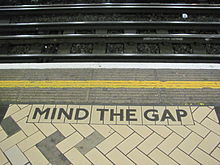 The London Underground (aka the Tube) is a railway system in London that’s used by 3.25 million passengers every day. The system has recognised the power of effective communication and design almost since it began back in 1863. Some elements have affected engineering projects around the world, and probably still do today.
The London Underground (aka the Tube) is a railway system in London that’s used by 3.25 million passengers every day. The system has recognised the power of effective communication and design almost since it began back in 1863. Some elements have affected engineering projects around the world, and probably still do today.
In this post, we’ll look at a few ways the system communicates information to staff and customers.
Mind the Gap
“Mind the gap” is probably the most famous set of user instructions in the world. Since 1969, this three-word command has been a warning to train passengers to take care at some stations when they get off the train. It’s needed because some platforms on the Underground follow the road above and are curved. As the underground cars are straight, it creates an unsafe gap when the train stops at those stations.
These three words, “mind the gap,” are a great example of why technical writing should not be measured solely by the number of words written per day.
The London Underground Map
The tube map, designed by Harry Beck in 1931, was the first city train network map to abandon a geographic map of the stations, and use a schematic representation instead.


The basic design concepts have been widely adopted for other network maps around the world, and it was voted a UK design icon in 2006.
According to Wikipedia:
“Beck was a London Underground employee who realised that because the railway ran mostly underground, the physical locations of the stations were irrelevant to the traveller wanting to know how to get to one station from another—only the topology of the railway mattered.”
Crossrail and The New Engineering Contract
 Crossrail is a new commuter rail service project for London and the South East. Costing approximately £15,000,000,000 ($23,322,000,000), the project uses The New Engineering Contract (NEC) to help ensure the project won’t suffer from significant cost overruns.
Crossrail is a new commuter rail service project for London and the South East. Costing approximately £15,000,000,000 ($23,322,000,000), the project uses The New Engineering Contract (NEC) to help ensure the project won’t suffer from significant cost overruns.
NEC is a system for drafting and obtaining tenders, and awarding and managing contracts on civil engineering and construction projects. According to Wikipedia, the NEC’s family of standard contracts each have these characteristics:
- Its use stimulates good management of the relationship between the two parties to the contract and, hence, of the work included in the contract.
- It can be used in a wide variety of commercial situations, for a wide variety of types of work and in any location.
- It is a clear and simple document—using language and a structure which are straightforward and easily understood.
NEC has led to the UK government approving a number of large engineering projects, as they now have greater confidence these type of projects will not run massively over-budget.
The Business Case Development Manual
According to Transport for London, all projects involving capital expenditure, changes in day-to-day operating expenditure and setting and revising standards must be justified and prioritised in accordance with London Underground’s Business Case Development Manual (BCDM). The BCDM sets out the steps and methodology for making a business case, with the goal of controlling the cost of managing a safe service.
It is not straightforward to make a business case for something that can be for the social good. For example, how do you quantify the business benefit of redesigning stations so they are wheelchair-friendly? Best practice, particularly if you want architecture-led design may cost more. BCDM offers some advice, but it can be hard to quantify quality.
There’s Lots More
This information, and a lot more, is available on the Transport for London website.
Please share your ideas, thoughts and suggestions in the comment box below.
Ellis Pratt is sales and marketing director at Cherryleaf. Ranked the most the influential blogger on technical communication in Europe, Ellis is a specialist in the field of creating clear and simple information users will love.

